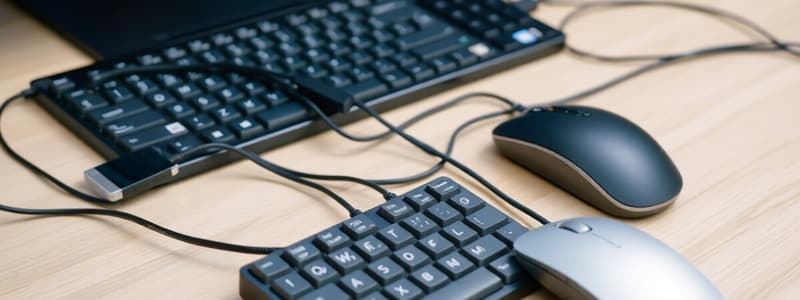Podcast
Questions and Answers
What is the primary function of BIOS in a computer?
What is the primary function of BIOS in a computer?
- To perform a self-test at startup (correct)
- To store data permanently
- To manage network connections
- To control hardware devices during operation
Which component primarily prevents the buildup of static electricity?
Which component primarily prevents the buildup of static electricity?
- Anti-Static product (correct)
- Hard-disk drive
- Graphic tablet
- Operating System
What does RAM stand for in computer terminology?
What does RAM stand for in computer terminology?
- Random Access Memory (correct)
- Read Access Memory
- Root Access Memory
- Rapid Access Memory
Which device allows a player to control movements on a computer screen or video game?
Which device allows a player to control movements on a computer screen or video game?
What is the main purpose of a Network Interface Card (NIC)?
What is the main purpose of a Network Interface Card (NIC)?
Which statement accurately describes a printer's function?
Which statement accurately describes a printer's function?
Which of the following best describes the term 'software' in computing?
Which of the following best describes the term 'software' in computing?
What is considered an internal device in a computer system?
What is considered an internal device in a computer system?
Flashcards
Anti-Static
Anti-Static
A product that prevents the buildup of static electricity.
BIOS
BIOS
A chip that controls the basic functions of a computer and performs a self-test each time you turn it on.
Hard Disk Drive
Hard Disk Drive
A storage device that stores billions of characters of data on a non-removable disk.
Hardware
Hardware
Signup and view all the flashcards
Joystick
Joystick
Signup and view all the flashcards
LAN Card
LAN Card
Signup and view all the flashcards
Multi-tester
Multi-tester
Signup and view all the flashcards
NIC (Network Interface Card)
NIC (Network Interface Card)
Signup and view all the flashcards
Study Notes
Peripheral Device Installation
- Peripheral devices are not essential for computer operation.
- Some peripherals are crucial for meaningful work.
- Two types of peripheral devices exist:
- Internal: Installed inside the computer case (e.g., expansion cards, new hard drives).
- External: Attached to the computer's exterior via ports (e.g., monitor, keyboard, mouse, speakers, printers).
Keyboard Installation
- Instructions should be followed from the manufacturer.
- Determine the type of connection for the keyboard (PS/2 or USB).
- PS/2 connectors are typically round and purple.
- USB connectors are typically flat and rectangular.
- Plug the keyboard into the chosen port.
- Do not install/uninstall the keyboard while the computer is on to prevent data loss.
Mouse Installation
- Mouse installation is similar to keyboard installation.
- Newer mice use USB connections.
- Use adapters to convert USB to PS/2 connections.
- Plug the mouse into the proper port.
Monitor Installation
- Installing a monitor requires an outlet and finding the correct connection type.
- Both DVI and VGA are common connections.
- Use the digital DVI port for the best picture quality.
- If available, graphics cards often support multiple monitors with required adapters.
- Follow manufacturer's instructions for more details.
Speaker Installation
- Speaker installation varies depending on the speakers.
- Simple speakers use a cable connecting to the computer's sound card.
- Full surround systems may require more complex connections and power cords.
- Some speakers have their own sound cards and only require power connections.
- Follow manufacturer's instructions.
Webcam Installation
- Most webcams are USB-powered.
- Drivers need installation in certain cases.
- Read instructions to avoid problems.
- FireWire connection may be faster than USB but requires the FireWire port on the computer.
Printer Installation
- Ensure appropriate cables (power and data) are available.
- Install the USB or parallel cable.
- Install necessary cartridges/toners.
- Turn on the printer.
- Wait for the Windows installer to begin and follow prompts.
- Use the installation CD if provided.
- Run a test print to verify correct installation.
Scanner Installation
- Scanner installation is similar to printer installation.
- Install drivers and plug in the USB cable.
- Follow manufacturer's instructions.
Studying That Suits You
Use AI to generate personalized quizzes and flashcards to suit your learning preferences.




